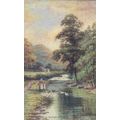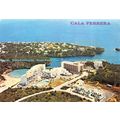Arundel, W Sussex - from river - AR Quinton postcard, Salmon *2050 - c.1920s
- Condition : Used
- Dispatch : 2 Days
- Brand : None
- ID# : 206263242
- Quantity : 1 item
- Views : 237
- Location : United Kingdom

- Seller : justthebook (+1699)
- Barcode : None
- Start : Wed 29 Dec 2021 17:49:24 (BST)
- Close : Run Until Sold
- Remain : Run Until Sold
More Listings from This Seller view all
Seller's Description
- Postcard
- Picture / Image: Arundel from the River [West Sussex] - by AR Quinton
- Publisher: J Salmon *2050
- Postally used: no
- Stamp: n/a
- Postmark(s): n/a
- Sent to: n/a
- Notes / condition: very good
Please ask if you need any other information and I will do the best I can to answer.
Image may be low res for illustrative purposes - if you need a higher definition image then please contact me and I may be able to send one. No cards have been trimmed (unless stated).
------------------------------------------------
Postage & Packing:
Postage and packing charge should be showing for your location (contact if not sure).
No additional charges for more than one postcard. You can buy as many postcards from me as you like and you will just pay the fee above once. Please wait for combined invoice. (If buying postcards with other things such as books, please contact or wait for invoice before paying).
Payment Methods:
UK - PayPal, Cheque (from UK bank) or postal order
Outside UK: PayPal ONLY (unless otherwise stated) please. NO non-UK currency checks or money orders (sorry).
NOTE: All postcards are sent in brand new stiffened envelopes which I have bought for the task. These are specially made to protect postcards and you may be able to re-use them. In addition there are other costs to sending so the above charge is not just for the stamp!
I will give a full refund if you are not fully satisfied with the postcard.
----------------------------------------------
Text from the free encyclopedia WIKIPEDIA may appear below to give a little background information (internal links may not work) :
*************
Arundel (/ˈærəndəl/ or locally /ˈɑːndəl/) is a market town and civil parish in a steep vale of the South Downs, West Sussex, England.
The much-conserved town has a medieval castle and Roman Catholic cathedral. Although smaller in population than most other parishes, Arundel has a museum and comes second behind much larger Chichester in its number of listed buildings in West Sussex. The River Arun runs through the eastern side of the town.
Arundel was one of the boroughs reformed by the Municipal Reform Act 1835. From 1836 to 1889 the town had its own Borough police force with a strength of three.[3] In 1974 it became part of the Arun district, and is now a civil parish with a town council.
Arundel civil parish occupies an area somewhat larger than its built-up clusters, with the old town towards the north and the new to the south, separated by a main road.[6]
The River Arun at Arundel.
Arundel town is a major bridging point over the River Arun as it was the lowest road bridge until the opening of the Littlehampton swing bridge in 1908. Arundel Castle was built by the Normans to protect that vulnerable fairly wooded plain to the north of the valley through the South Downs. The town later grew up on the slope below the castle to the south.[7] The river was previously called the Tarrant and was renamed after the town by antiquarians in a back-formation.
Arundel includes meadows to the south but is clustered north of the A27 road, which narrowly avoids the town centre by a short and congested single carriageway bypass. Plans for a more extensive, HQDC bypass were debated intensely between 1980 and 2010 and a junction was built for it at Crossbush. In Spring 2018, Highways England published their preferred route for the new bypass.[8] During 2018-19 there is a further period of consultation when views on a more detailed design for the four-mile dual carriageway will be sought.
Arundel railway station is on the Arun Valley Line. The Monarch's Way long-distance footpath passes through the town and crosses the river here, while just under five miles north and north-west of the town the route of the South Downs Way runs.
The town itself lies outside the boundaries of the South Downs National Park.
Alfred Robert Quinton (28 October 1853 – 10 December 1934)[1] was an English watercolour artist, known for his paintings of British villages and landscapes many of which were published as postcards.
Quinton was born in Peckham in London in 1853,[2] the youngest of seven children of Elizabeth née Cullum (1818-1886) and John Allen Quinton (1817-1906), a printer, author and journalist.[1][3] On leaving school A. R. Quinton studied painting at the Heatherley School of Fine Art following which he worked as a steel engraver, but deciding on a career in art he began to work in oils in about 1874 and after in watercolour, working from a studio in Fleet Street in London and after at Lincoln's Inn, exhibiting several of his watercolour paintings at the latter with the Ipswich Fine Art Club in 1882 and 1883. From 1877 Quinton exhibited watercolours at the Royal Society of British Artists.[1]
He married Elizabeth Annie Crompton (1858-1946) at Bolton in Lancashire in May 1885[4] and with her had two sons: Leonard Quinton (1886-1981) and Edgar Allan Quinton (1891-1912).[2]
n 1895 he and a friend cycled from Land's End to John O'Groats and Quinton's artworks from the trip were after serialised in the Illustrated Sporting and Dramatic News. His artwork became more in demand and he was able to buy a house with a studio in Finchley in London. His work routine would be to travel around England and Wales for three months of the year, mostly during the summer months and often by bicycle, during which he would draw sketches and take photographs of locations which he would work up into paintings in his studio during the winter months. Many of his artworks were published as postcards by Raphael Tuck and J Salmon Ltd which remain popular with today's collectors. His paintings have also been published in many calendars. Well over 2,000 of his paintings were published between 1904 and the time of his death. He also illustrated a number of books including The Historic Thames by Hilaire Belloc.[1]
He exhibited at the Birmingham Royal Society of British Artists; Dudley Gallery; Dowdeswell Gallery; Grosvenor Gallery; Liverpool Walker Art Gallery; Manchester City Art Gallery; the Royal Society of British Artists; Royal Hibernian Academy; Royal Institute of Painters in Water Colour and the Royal Institute of Oil Painters. He exhibited at the Royal Academy but he was later banned from exhibiting there as the authorities were not in favour of his 'commercialisation' of art. His original illustrations for the book The Historic Thames and two other of his paintings were bought by the Duke and Duchess of Kent.[1]
Alfred Robert Quinton died in Finchley in London in December 1934, and left £9,228 2s 8d in his will to his widow and his surviving son.[5]
Listing Information
| Listing Type | Gallery Listing |
| Listing ID# | 206263242 |
| Start Time | Wed 29 Dec 2021 17:49:24 (BST) |
| Close Time | Run Until Sold |
| Starting Bid | Fixed Price (no bidding) |
| Item Condition | Used |
| Bids | 0 |
| Views | 237 |
| Dispatch Time | 2 Days |
| Quantity | 1 |
| Location | United Kingdom |
| Auto Extend | No |



 for 1 item(s)
for 1 item(s)















